Celtic knots symbolize eternal connection through their continuous, unbroken lines that have no beginning or end. Dating back to 450 AD, these intricate designs represent the endless cycle of life, love, and spiritual unity. You’ll find them in ancient manuscripts like the Book of Kells and modern jewelry alike. The knots’ mathematical complexity mirrors the interconnectedness of existence itself. Their enduring appeal reveals deeper meanings about relationships that transcend time and physical boundaries.
Why Do Celtic Knots Symbolize Eternal Connection?
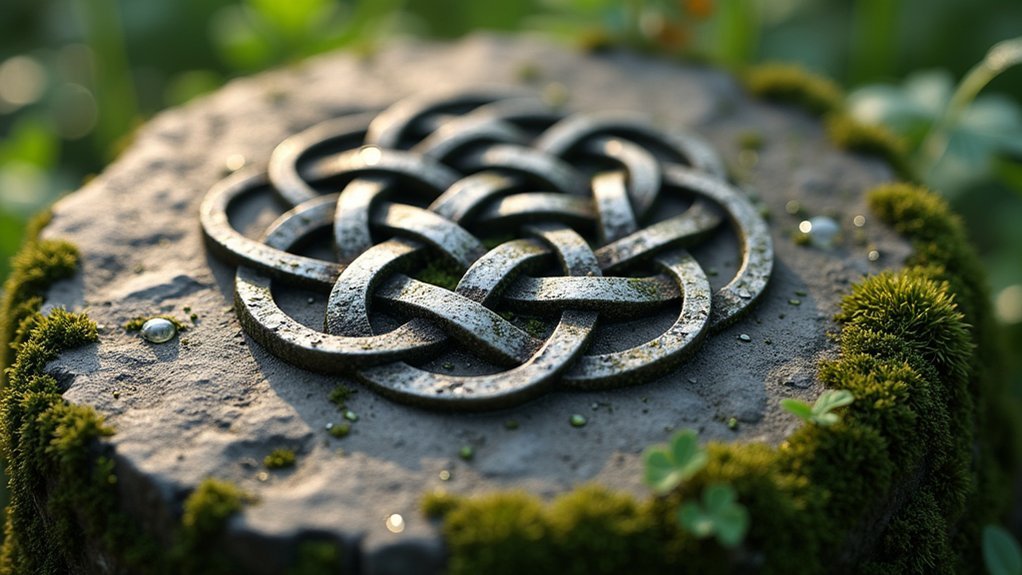
Infinity flows through every curve of Celtic knotwork, where unbroken lines intertwine without beginning or end. This visual representation of continuity is why Celtic knots meaning centers on eternal connection—they’re physical manifestations of life’s unbreakable threads.
When you examine these intricate designs, you’ll notice how they mirror Celtic culture’s deep reverence for interconnectedness. Each loop and weave symbolizes relationships that transcend time, illustrating how love and friendship endure beyond physical existence.
The Trinity Knot particularly exemplifies this concept, representing the cycle of life through its three-cornered design. As your fingers trace these patterns, you’re connecting with ancient wisdom that recognized how all beings share a common journey—birth, life, and transformation—bound together in an endless, sacred continuum.
The Origins of Celtic Knot Symbolism in Ancient Europe
You’ll find the roots of Celtic knot designs in Roman mosaics that influenced early Celtic artisans across ancient Europe.
These intricate patterns evolved from pre-Christian Celtic designs, where they represented the eternal cycle of life and natural interconnectedness.
The tradition reached its artistic peak in illuminated manuscripts like the Book of Kells, where monks transformed these ancient symbols into elaborate Christian artwork by the 7th century.
Knotwork’s Roman Mosaic Roots
Although widely associated with Celtic culture, the intricate knotwork we recognize today has surprising origins in Roman artistic traditions. When you examine 3rd and 4th century Roman mosaics, you’ll find the earliest examples of interwoven patterns that later defined Celtic knotwork.
As Celts migrated across Europe, they encountered these Roman art forms and incorporated the intricate designs into their own expressions. You can trace this evolution through artifacts like the 7th-century Gospel Book fragment at Durham Cathedral, where Roman influences blend with Celtic traditions.
The patterns gained deeper spiritual significance under early Christian influences, symbolizing interconnectedness and eternal connection without beginning or end.
What began as decorative floor mosaics transformed into powerful symbols that continue to represent the infinite cycle of life and spiritual bonds.
Pre-Christian Celtic Designs
While Roman influences shaped much of what we recognize as Celtic knotwork today, pre-Christian Celtic tribes had already developed their own symbolic language through intricate designs by 450 AD.
These early Celtic knots reflected their deep connection to nature and spiritual beliefs, emphasizing the cycle of life through continuous, unbroken lines.
You’ll find these ancient patterns carved into stone monuments and artifacts across Europe, where they tell cultural stories through their meticulous craftsmanship.
The intricate interweaving wasn’t merely decorative—it represented interconnectedness between all living things. Each knot’s continuous path symbolized eternity, with no discernible beginning or end.
This pre-Christian symbolism laid the foundation for what would later evolve as Christianity spread through Celtic lands, adapting these powerful motifs rather than eliminating their profound spiritual significance.
Book of Kells Connection
As Christianity spread through Celtic territories in the early medieval period, the magnificent Book of Kells emerged as perhaps the most celebrated example of Celtic artistic tradition merging with Christian symbolism.
This 9th-century illuminated manuscript showcases the profound cultural exchange between ancient beliefs and new religious themes through intricate Celtic knots.
When you examine these designs, you’ll notice three key elements:
- Interwoven lines symbolizing the interconnectedness of life
- Trinity Knots representing the Holy Trinity and unity of body, mind, and spirit
- Endless patterns reflecting the cycle of birth, death, and rebirth
Beyond their aesthetic beauty, these knots convey deeper philosophical messages about existence and divine connection.
The Book of Kells stands as evidence to how Celtic artistic traditions carried spiritual significance while adapting to new religious contexts.
Unbroken Lines: The Mathematics Behind Celtic Knot Patterns
Elegance in mathematical precision defines the fascinating world of Celtic knots. When you examine these intricate patterns closely, you’ll discover they’re formed from continuous, unbroken lines that never truly begin or end—a physical representation of interconnectedness that’s both visually stunning and mathematically complex.
The mathematical basis of these designs involves advanced geometric principles and knot theory. You’re witnessing a single continuous line that weaves through itself in calculated patterns, creating the endless cycle that symbolizes eternity in Celtic culture.
This mathematical foundation strengthens the knots’ spiritual meanings, where designs like the Trinity Knot and Dara Knot represent unity through their complex configurations. The mathematical elegance of these patterns isn’t just aesthetic—it’s fundamental to how Celtic knots convey concepts of infinity and spiritual continuity.
Celtic Knots in Historical Manuscripts and Stone Carvings
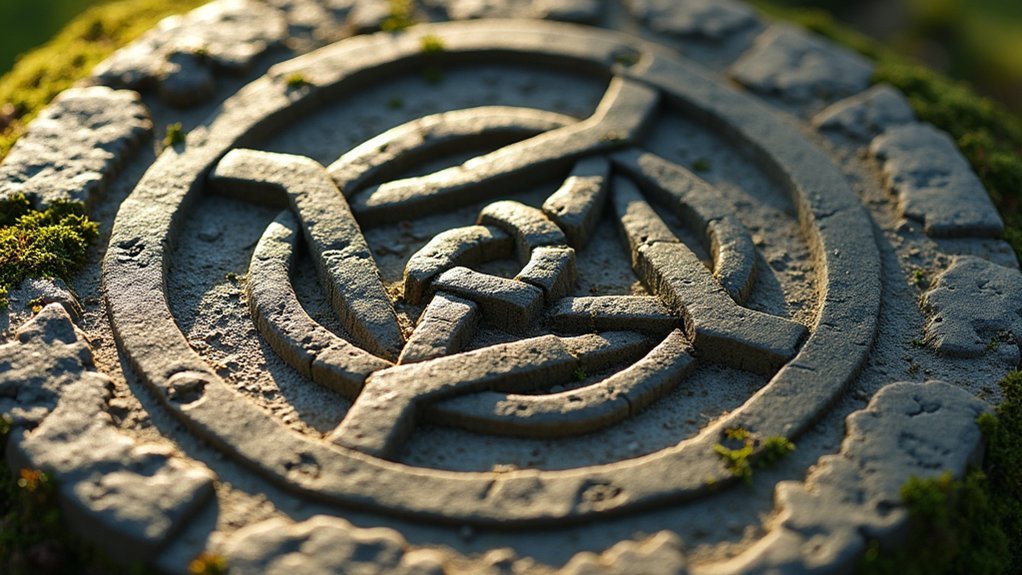
The mathematical precision of Celtic knots found physical expression in some of humanity’s most treasured artifacts. When you examine historical manuscripts like the Book of Kells or the Lindisfarne Gospels, you’ll witness these intricate designs seamlessly blending artistry with Celtic spirituality.
Celtic artistry transcends decoration, weaving mathematical precision with spiritual meaning in every unbroken line.
Dating back to at least the 7th century, these symbols transcend mere decoration in three distinct ways:
- In ancient sites across Scotland and Ireland, stone carvings reveal how Celtic culture embedded these patterns into sacred spaces.
- At Kilmartin Glen, the knots demonstrate exceptional craftsmanship while telling complex stories of interconnectedness.
- Within manuscripts, the unbroken lines symbolize eternal cycles, visually representing the Celtic worldview.
These enduring artifacts show how symbolism in Celtic knots bridged everyday life with deeper spiritual meanings.
The Trinity Knot: Three-fold Meaning in Celtic Tradition
Among all Celtic motifs, the Trinity Knot stands apart with its deceptively simple yet profound symbolism that has resonated across centuries. When you examine this iconic Celtic design, you’ll discover how it elegantly captures the interconnectedness of life through three interlocking loops.
| Trinity Knot Aspect | Celtic Tradition | Modern Interpretation |
|---|---|---|
| Three Arcs | Three stages of a woman’s life: maiden, mother, crone | Holy Trinity in Christianity |
| Continuous Line | Cyclical nature of existence | Eternal love without beginning or end |
| Interlocking Design | Unity of mind, body, spirit | Family bonds and connections |
| Appearance in Book of Kells | Sacred knowledge transmission | Historical artistic significance |
| No Beginning or End | Life, death, and rebirth cycle | Infinity and timelessness |
Love Knots and Relationship Symbolism in Celtic Jewelry
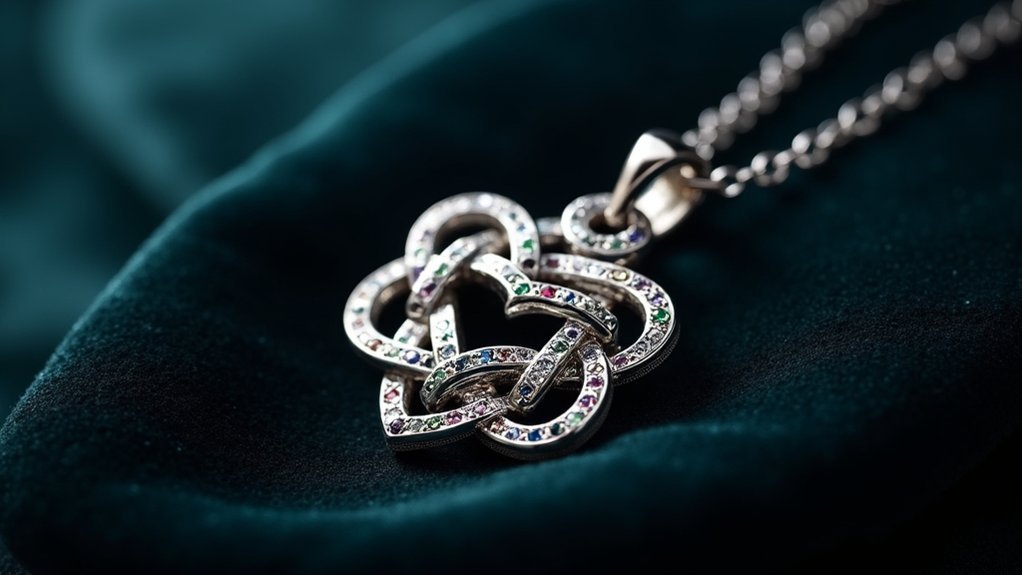
Woven with intricate patterns that speak of devotion beyond words, Celtic Love Knots have emerged as powerful symbols of romantic commitment in the domain of traditional jewelry.
These interconnected designs capture the essence of eternal love, illustrating how relationships have no true beginning or end.
When you wear a piece featuring these intricate designs, you’re embracing symbols of:
- Unbreakable bonds – Each intertwined heart represents the inseparable connection between partners.
- Continuous devotion – The endless loops symbolize commitment that withstands time’s tests.
- Shared journeys – Every twist and turn reflects the complex paths couples navigate together.
Popular in wedding bands and promise rings, Celtic Love Knots celebrate the unity and lasting connections that define meaningful relationships, making them powerful emblems of relationship symbolism.
Celtic Knots as Spiritual Protection and Divine Connection
Beyond their aesthetic beauty, Celtic knots serve as powerful spiritual shields that connect wearers to divine spheres and ancient protective forces. When you wear these protective symbols, you’re embracing a tradition where unbroken lines create barriers against negative energies while establishing an eternal connection to something greater than yourself.
The Shield Knot exemplifies this purpose, historically safeguarding warriors in battle and spiritually shielding them from malevolent spirits. These intricate designs represent the interconnectedness between physical and spiritual domains, constant reminders of divine presence in your daily experience.
The continuous patterns reflect the cycle of life and journey of the soul, weaving together protection with spiritual purpose. In Celtic spirituality, these knots don’t merely protect—they integrate you into the cosmic web of existence, binding your path to ancient wisdom.
From Book of Kells to Modern Jewelry: Evolution of Celtic Designs
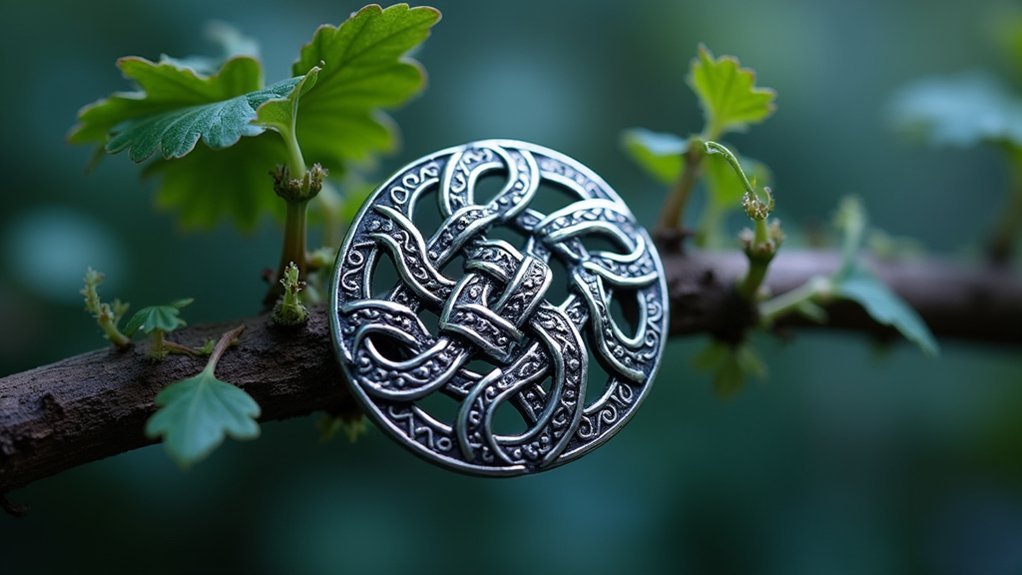
The magnificent Book of Kells stands as the crowning achievement of Celtic knotwork artistry, capturing the pinnacle of these designs before they began their centuries-long evolution into the forms we recognize today.
Celtic art’s journey from Roman-influenced floor mosaics to distinctly Irish expressions showcases humanity’s enduring fascination with interconnectedness.
You’ll find this evolution reflected in three distinct stages:
- Ancient Origins – Roman mosaics transforming into uniquely Celtic expressions of spirituality
- Medieval Flourishing – Manuscripts and religious artifacts incorporating knots as symbols of unity
- Modern Revival – Contemporary jewelry featuring the Trinity Knot and Celtic Love Knot
Today’s popularity of Celtic heritage in modern jewelry isn’t merely decorative—it’s a conscious connection to ancient symbolism that continues to resonate across generations.
Cultural Significance of Celtic Knots in Scottish and Irish Heritage
Celtic knots serve as powerful cultural touchstones within Scottish and Irish heritage, carrying meanings that transcend their artistic beauty. When you explore sites like Iona Abbey or Kilmartin Glen, you’ll witness how these intricate designs have become inseparable from Scottish identity, commemorating life and ancestry through stone carvings and architecture.
Celtic knots weave Scotland’s soul into stone, connecting generations through intricate patterns that speak beyond their visual splendor.
The ancient Celtic belief in life’s cyclical nature infuses these patterns with profound cultural significance. You’ll find the Trinity Knot representing spiritual unity and the Dara Knot symbolizing strength throughout Celtic history. Both designs reflect the interconnectedness valued in Irish heritage.
Beyond decoration, these knots embodied eternal connection, binding religious artifacts and manuscripts like the Book of Kells, where Celtic spirituality merged with Christianity.
Today, they continue to bridge past and present, reminding us of our enduring cultural roots.
The Endless Loop: Celtic Knots and the Cycle of Life Philosophy
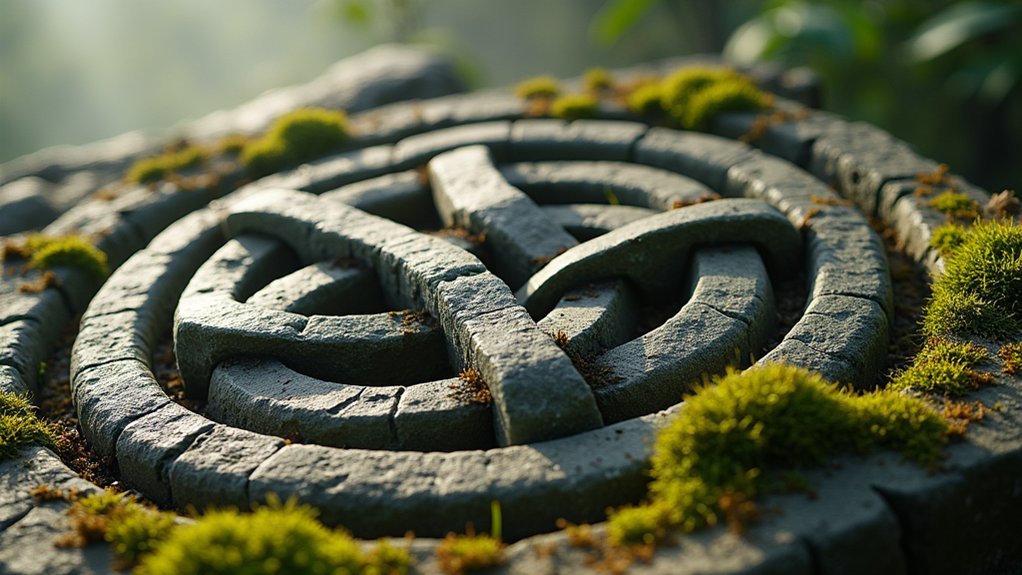
Encoded within every Celtic knot’s unbroken lines lies a profound philosophy that extends far beyond artistic expression.
You’ll find these Celtic symbols represent the eternal cycle connecting all aspects of existence through their intricate designs.
When you examine an endless knot, you’re witnessing an ancient understanding of interconnectedness that mirrors life’s fundamental truths:
- Beginning merges with ending – The continuous patterns symbolize how life and death form one unbroken journey.
- Paths intertwine yet never end – Reflecting how love and friendship weave through our existence, creating lasting bonds.
- Complexity emerges from simplicity – Each knot’s elaborate design evolves from basic principles, just as complex life emerges from fundamental elements.
This philosophy resonates across cultures, reminding us that everything remains eternally connected.
Celtic Knot Variations and Their Specific Symbolic Meanings
Diverse in both design and meaning, each Celtic knot variation carries its own unique symbolic language while maintaining the fundamental principle of eternal connection.
You’ll find the Trinity Knot (Triquetra) expressing spiritual unity and interconnectedness of life cycles, while the Dara Knot mirrors oak tree roots, embodying strength and the deep bonds between all living things.
When you seek protection, the Shield Knot serves as your spiritual guardian against negative forces.
For matters of the heart, the Lovers Knot, with its interlocking hearts, celebrates eternal love that transcends time.
Meanwhile, the Sailor’s Knot represents enduring bonds of friendship and loyalty, particularly meaningful in seafaring traditions.
These Celtic knots aren’t merely decorative patterns but profound symbols that continue to remind us of life’s unbreakable connections.
Frequently Asked Questions
What Does the Celtic Eternity Knot Mean?
The Celtic Eternity Knot symbolizes eternal connection in your life. You’ll find it represents endless love, unbroken spiritual bonds, and life’s continuous cycle. It’s a powerful reminder that true connections don’t have beginnings or endings.
What Knot Is the Symbol of Eternal Love?
The Celtic Love Knot is your symbol of eternal love. With its intertwined hearts forming a continuous pattern without beginning or end, it represents your unbreakable bond and the beautiful complexity of love’s endless journey.
What Does the Eternal Knot Symbolize?
The eternal knot symbolizes life’s interconnectedness without beginning or end. You’ll find it represents the continuous cycles of existence, showing how all things—birth, death, relationships—are deeply intertwined in an everlasting pattern.
What Does the Celtic Knot Mean Spiritually?
Spiritually, you’ll find Celtic knots represent your eternal connection to all beings. They’re powerful symbols of your continuous spiritual journey, the unity of your soul with others, and life’s unending cycles beyond physical existence.
In Summary
In your exploration of Celtic knots, you’ve discovered why they’re powerful symbols of eternal connection. Their unbroken lines flow continuously, representing the infinite nature of life, love, and spiritual bonds. Whether you’re drawn to their mathematical precision or cultural significance, these ancient designs remind you that connections don’t end—they simply transform and continue. Celtic knots remain timeless messengers of our enduring human bonds.





Leave a Reply